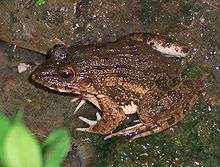Crab-eating frog
The crab-eating frog (Fejervarya cancrivora) is a frog native to south-eastern Asia including Taiwan,[2] China, the Philippines and more rarely as far west as Orissa in India.[3] It has also been introduced to Guam, and was most likely introduced from Taiwan.[4] It inhabits mangrove swamps and marshes and is one of only 144 known modern amphibians which can tolerate brief excursions into sea water[5].
| Crab-eating frog | |
|---|---|
 | |
| Fejervarya cancrivora from Bogor, West Java | |
| Scientific classification | |
| Kingdom: | Animalia |
| Phylum: | Chordata |
| Class: | Amphibia |
| Order: | Anura |
| Family: | Dicroglossidae |
| Genus: | Fejervarya |
| Species: | F. cancrivora |
| Binomial name | |
| Fejervarya cancrivora (Gravenhorst, 1829) | |
| Synonyms | |
|
Rana cancrivora Gravenhorst, 1829 | |
This frog can tolerate marine environments (immersion in sea water for brief periods or brackish water for extended periods) by increasing urea production and retention, and by remaining slightly hyperosmotic within urea and sodium flux.[6][7][8] Adults can survive in salt water with salinity as high as 2.8%, and tadpoles can survive salinities as high as 3.9%.[9]
Diet
The food sources of the crab-eating frog are mainly determined by the locally available prey. Near fresh water, its diet consists largely of insects. But in an environment with brackish water, small crustaceans, including crabs, form the main part.[10]
Human consumption
In Southeast Asia, the crab-eating frog is locally hunted for food and is often farmed for its edible legs, including in Java, Indonesia.[11]
References
- Yuan, Zhigang; Zhao, Ermi; Shi, Haitao; Diesmos, Arvin C.; Alcala, Angel C.; Brown, Rafe M.; Afuang, Leticia E.; Gee, Genevieve V. A.; Sukumaran, Jeet; Yaakob, Norsham Suhaina; et al. (2004). "Fejervarya cancrivora". IUCN Red List of Threatened Species. 2004: e.T58269A11759436. doi:10.2305/IUCN.UK.2004.RLTS.T58269A11759436.en.
- Lue, Kuang-Yang. "Fejervarya cancrivora". BiotaTaiwanica. Archived from the original on 16 December 2016. Retrieved 12 December 2012.
- Rare species of frog, snake in Orissa
- Wostl, Elijah, Eric N. Smith, and Robert N. Reed. 2016. Origin and Identity of Fejervarya (Anura: Dicroglossidae) on Guam. Pacific Science 70(2):233-241. https://doi.org/10.2984/70.2.9
- Hopkins, Gareth R.; Brodie, Edmund D. (2015). "Occurrence of Amphibians in Saline Habitats: A Review and Evolutionary Perspective". Herpetological Monographs. 29: 1–27. doi:10.1655/HERPMONOGRAPHS-D-14-00006.
- Schmidt-Nielsen, Knut; Lee, Ping (1962). "Kidney function in the crab-eating frog (Rana cancrivora)" (PDF). Journal of Experimental Biology. 39 (1): 167–177.
- Dicker, Sebastian Ernest; Elliott, Annie B. (March 1970). "Water uptake by the crab-eating frog Rana cancrivora, as affected by osmotic gradients and by neurohypophysial hormones". Journal of Physiology. 207 (1): 119–32. doi:10.1113/jphysiol.1970.sp009052. PMC 1348696. PMID 5503862.
- Tatsunori, Seki; Sakae, Kikuyama; Noboru, Yanaihara (1995-10-15). "Morphology of the skin glands of the crab-eating frog: Rana cancrivora". Zoological Science. 12 (5): 623–6. doi:10.2108/zsj.12.623.
- Gordon, Malcolm S.; Schmidt-Nielsen, Knut; Kelly, Hamilton M. (1961), "Osmotic regulation in the crab-eating frog (Rana cancrivora)", Journal of Experimental Biology, 38 (3): 659–678
- Annie B. Elliott; Letha Karunakaran (October 1974). "Diet of Rana cancrivora in fresh water and brackish water environments". Journal of Zoology. 174 (2): 203–215. doi:10.1111/j.1469-7998.1974.tb03152.x.
- Kusrini, MD (2005). Edible frog harvesting in Indonesia: evaluating its impact and ecological context. Ph.D. dissertation, James Cook University.
- Berry, P. Y. (1975). The Amphibian Fauna of Peninsular Malaysia. Kuala Lumpur: Tropical Press.
- Inger, Robert F. (1966). The Systematics and Zoogeography of the Amphibia of Borneo. Chicago (IL): Field Museum of Natural History. ISBN 983-99659-0-5.
- Inger, Robert F.; Stuebing, Robert B. (1997). A Field guide to the Frogs of Borneo (2nd ed.). Kota Kinabalu, Borneo: Natural History Publications. ISBN 983-812-085-5.
- Iskandar, Djoko Tjahono (1998). Amfibi Jawa dan Bali. Bogor (Indonesia): Puslitbang Biologi - LIPI. ISBN 979-579-015-3.
- Iskandar, Djoko Tjahono; Colijn, Ed (December 2000). "Preliminary Checklist of Southeast Asian and New Guinean Herpetofauna. I. Amphibians". Treubia. 31 (3 Suppl): 1–133.
